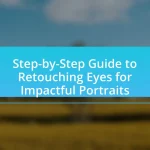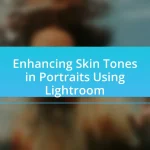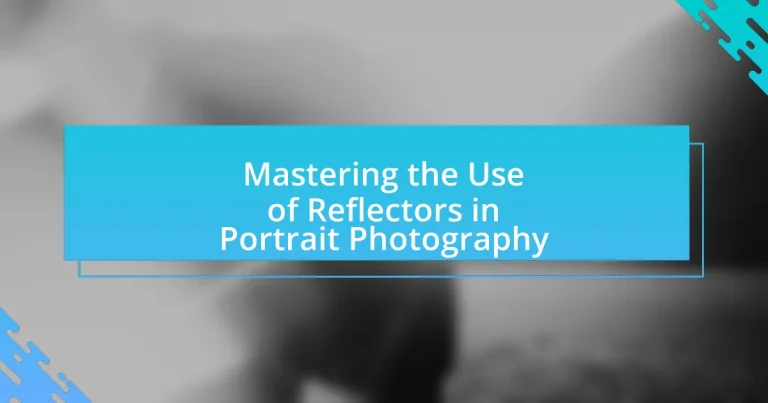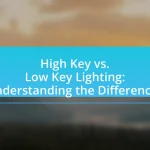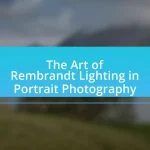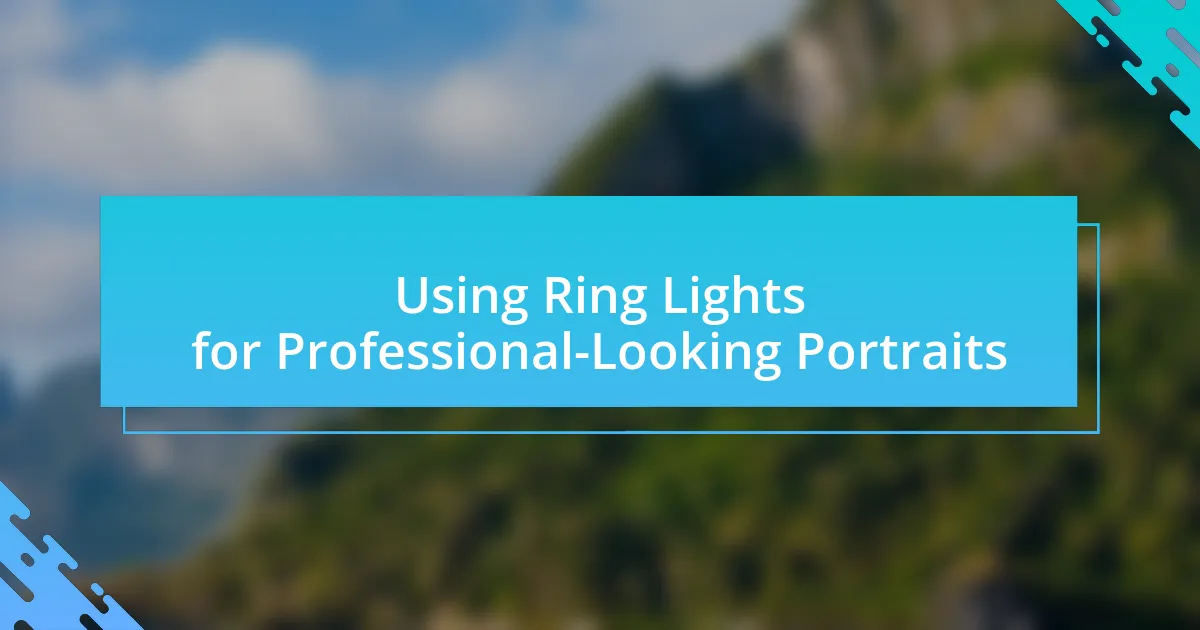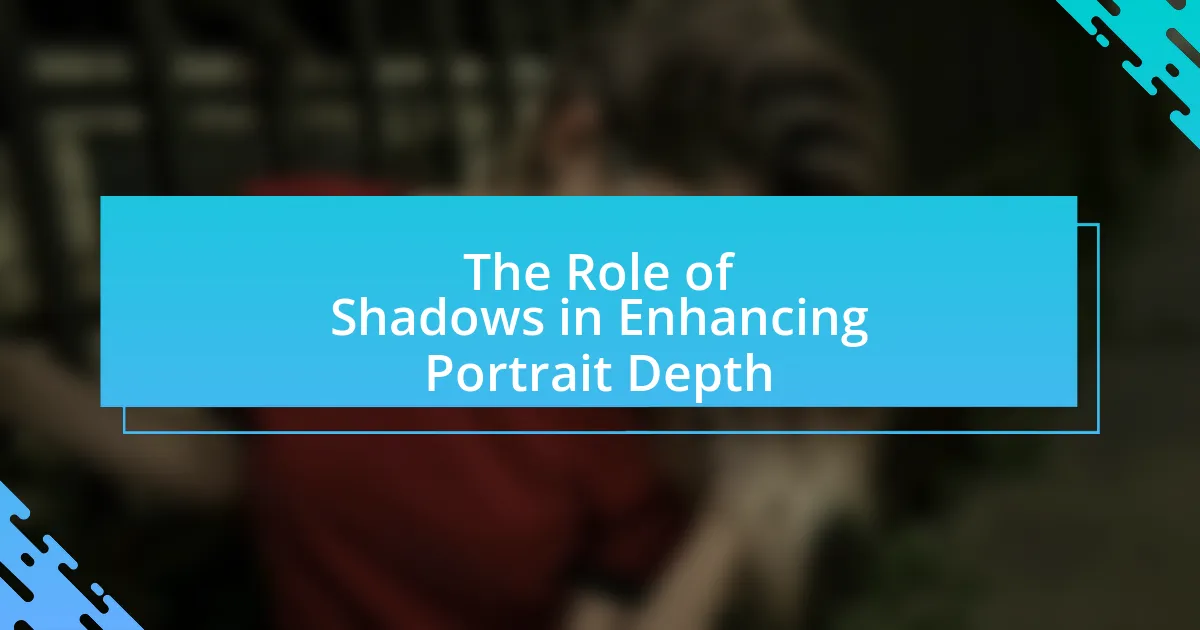Reflectors are essential tools in portrait photography, used to redirect and enhance light on subjects, thereby improving image quality by reducing shadows and creating balanced illumination. This article explores the various types of reflectors, including their materials, shapes, and sizes, and how they influence lighting conditions. It also discusses effective techniques for positioning reflectors, common mistakes to avoid, and the benefits of combining reflectors with other lighting equipment. By mastering the use of reflectors, photographers can achieve more flattering and professional-looking portraits.
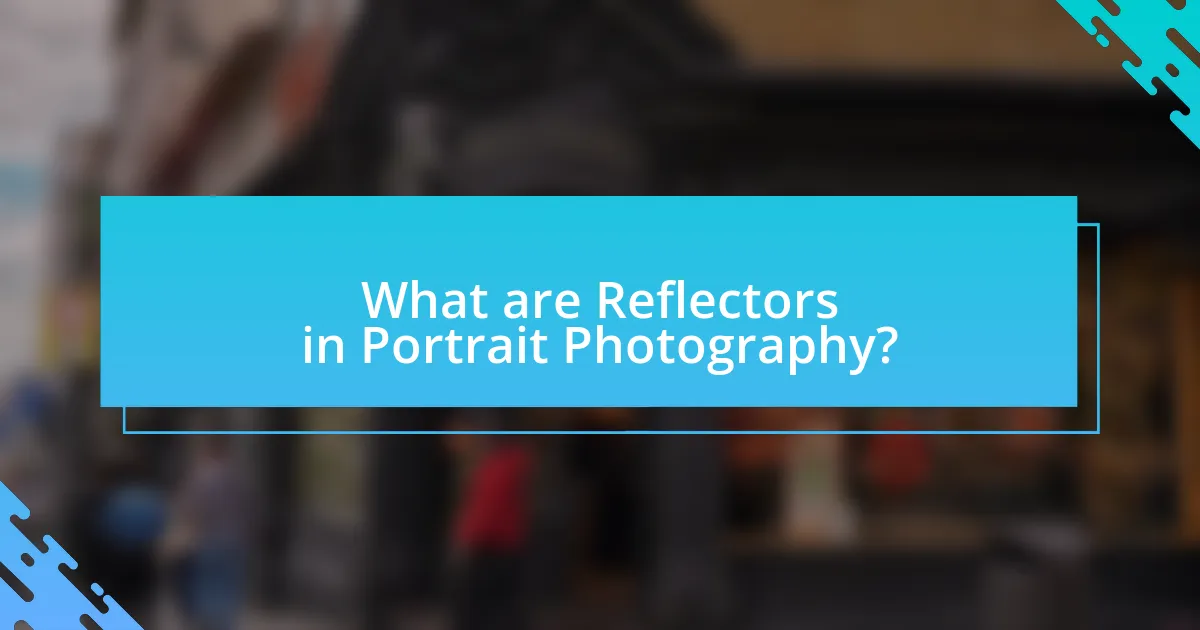
What are Reflectors in Portrait Photography?
Reflectors in portrait photography are tools used to redirect light onto a subject, enhancing illumination and reducing shadows. They come in various materials and colors, such as white, silver, and gold, each affecting the quality and warmth of the light. For instance, a white reflector produces soft, diffused light, while a silver reflector creates a more intense, specular highlight. The use of reflectors is essential for achieving balanced lighting, especially in outdoor settings where natural light can be harsh or uneven. Studies in photography emphasize that proper use of reflectors can significantly improve the overall quality of portrait images by providing controlled lighting conditions.
How do Reflectors Influence Lighting in Portraits?
Reflectors influence lighting in portraits by redirecting and softening light, which enhances the subject’s features and reduces harsh shadows. They achieve this by bouncing light from a source, such as the sun or artificial lights, onto the subject, creating a more flattering and even illumination. For instance, using a white reflector can increase the light on a subject’s face by up to two stops, significantly improving the overall exposure and detail in the portrait. This technique is widely utilized in portrait photography to achieve a professional look, as it allows photographers to control the quality and direction of light effectively.
What Types of Light Do Reflectors Modify?
Reflectors modify natural light, artificial light, and ambient light in portrait photography. Natural light, such as sunlight, can be redirected and softened by reflectors to enhance the subject’s features. Artificial light sources, like studio lights, can also be adjusted using reflectors to create desired highlights and shadows. Additionally, reflectors can manipulate ambient light, which is the existing light in a scene, to improve overall illumination and balance in portraits. This versatility in modifying different types of light makes reflectors essential tools for photographers aiming to achieve optimal lighting conditions.
How Does the Positioning of Reflectors Affect Light Quality?
The positioning of reflectors significantly affects light quality by altering the direction, intensity, and softness of the light that reaches the subject. When reflectors are placed closer to the subject, they create a more intense and focused light, enhancing details and reducing shadows. Conversely, positioning reflectors further away results in softer light, which can minimize harsh shadows and create a more flattering appearance. Research indicates that the angle of reflectors also plays a crucial role; for instance, reflectors angled towards the subject can produce a more even light distribution, while those angled away may create uneven lighting patterns. This understanding is essential for photographers aiming to achieve specific lighting effects in portrait photography.
Why are Reflectors Important in Portrait Photography?
Reflectors are important in portrait photography because they enhance lighting by redirecting natural or artificial light onto the subject. This technique helps to fill in shadows, create a more balanced exposure, and highlight facial features, resulting in a more flattering image. Studies show that using reflectors can significantly improve the quality of portraits by softening harsh light and reducing contrast, which is crucial for achieving a professional look.
What Advantages Do Reflectors Offer Over Other Lighting Tools?
Reflectors provide several advantages over other lighting tools, primarily their ability to manipulate natural light effectively and enhance the quality of illumination in portrait photography. Unlike artificial lighting sources, reflectors are lightweight, portable, and cost-effective, allowing photographers to achieve desired lighting effects without the need for extensive equipment. They can diffuse, bounce, or redirect light, creating softer shadows and reducing harsh contrasts, which is essential for flattering portraits. Additionally, reflectors can be used in various environments, making them versatile tools for both indoor and outdoor settings. Their effectiveness is supported by the fact that many professional photographers rely on reflectors to achieve natural-looking results, demonstrating their importance in the field.
How Can Reflectors Enhance the Subject’s Features?
Reflectors enhance a subject’s features by directing and diffusing light to create a more flattering illumination. This technique reduces harsh shadows, highlights facial contours, and adds a natural glow to the skin. For instance, using a white reflector can soften the light, making the subject’s skin appear smoother and more even-toned, while a gold reflector can impart a warm tone, enhancing the subject’s complexion. Studies in portrait photography demonstrate that proper use of reflectors can significantly improve the overall aesthetic quality of images, leading to more visually appealing results.
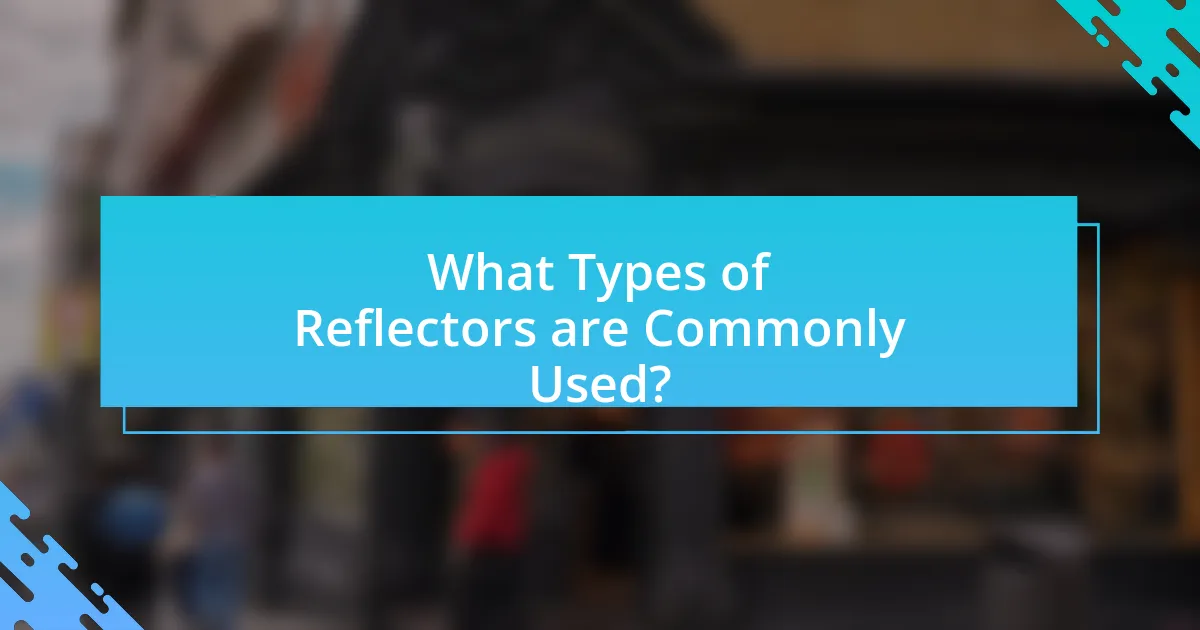
What Types of Reflectors are Commonly Used?
Commonly used types of reflectors in portrait photography include white, silver, gold, and black reflectors. White reflectors provide soft, diffused light, ideal for natural-looking portraits. Silver reflectors produce a more intense light, enhancing contrast and brightness, making them suitable for dramatic effects. Gold reflectors add warmth to the skin tones, creating a sun-kissed look, while black reflectors absorb light, helping to create shadows and depth in the image. These reflectors are essential tools for photographers to manipulate lighting conditions effectively.
What Materials are Reflectors Made From?
Reflectors are primarily made from materials such as foam board, silver or gold mylar, white fabric, and aluminum. Foam board is lightweight and easy to manipulate, making it a popular choice for portable reflectors. Silver mylar provides a high level of reflectivity, enhancing brightness, while gold mylar adds warmth to the light. White fabric offers a softer, diffused reflection, suitable for more natural lighting effects. Aluminum reflectors are durable and can be shaped to direct light effectively. These materials are chosen based on their reflective properties and suitability for various lighting conditions in portrait photography.
How Does the Material Impact the Reflector’s Performance?
The material of a reflector significantly impacts its performance by influencing light diffusion, color temperature, and durability. Different materials, such as silver, gold, or white fabric, alter how light is reflected and softened, affecting the quality of illumination on the subject. For instance, a silver reflector produces a more intense and cooler light, while a gold reflector creates warmer tones, enhancing skin tones in portrait photography. Additionally, the durability of the material affects the reflector’s longevity and usability in various environments, ensuring consistent performance over time.
What Are the Pros and Cons of Different Reflector Materials?
Different reflector materials have distinct pros and cons that affect their performance in portrait photography. For instance, silver reflectors provide a high level of brightness and contrast, making them ideal for creating dramatic lighting effects; however, they can produce harsh reflections that may not be flattering for all skin tones. Gold reflectors, on the other hand, add warmth to the light, enhancing skin tones, but they can sometimes create an overly warm effect if not used carefully. White reflectors offer a softer, more diffused light, which is flattering for portraits, but they may not provide enough brightness in low-light conditions. Black reflectors absorb light, allowing for shadow creation, which can add depth to images, but they do not reflect any light, limiting their use in bright environments. Each material’s effectiveness depends on the specific lighting conditions and the desired outcome in portrait photography.
What Shapes and Sizes of Reflectors are Available?
Reflectors are available in various shapes and sizes, including rectangular, square, round, and octagonal forms. Each shape serves different lighting needs; for instance, round reflectors provide a softer light, while rectangular reflectors can create more directional light. Sizes typically range from small handheld options, around 12 inches in diameter, to larger studio reflectors, which can be up to 60 inches or more. The choice of shape and size impacts the quality and direction of light in portrait photography, making it essential for photographers to select the appropriate reflector for their specific lighting requirements.
How Does the Shape of a Reflector Influence Light Distribution?
The shape of a reflector significantly influences light distribution by determining how light is redirected and spread across a subject. For instance, a parabolic reflector concentrates light into a focused beam, creating dramatic highlights and shadows, which is ideal for emphasizing facial features in portrait photography. Conversely, a circular or oval reflector disperses light more evenly, resulting in softer illumination that reduces harsh shadows, making it suitable for achieving a natural look. Research indicates that the angle and curvature of the reflector also affect the intensity and quality of light, as demonstrated in studies on light behavior in photography, which show that specific shapes can enhance or soften light based on their design.
What Size Reflector is Best for Different Portrait Scenarios?
The best size reflector for different portrait scenarios varies based on the desired effect and the environment. A 5-in-1 reflector, typically 42 inches in diameter, is versatile for most portrait situations, providing options for diffusing light or reflecting it in various colors. For close-up portraits, a smaller reflector, around 30 inches, is ideal as it allows for more controlled light and easier handling. In outdoor settings with harsh sunlight, a larger reflector, such as a 60-inch model, can effectively bounce light to fill shadows on the subject’s face. These sizes are commonly recommended by professional photographers for their adaptability and effectiveness in enhancing portrait lighting.
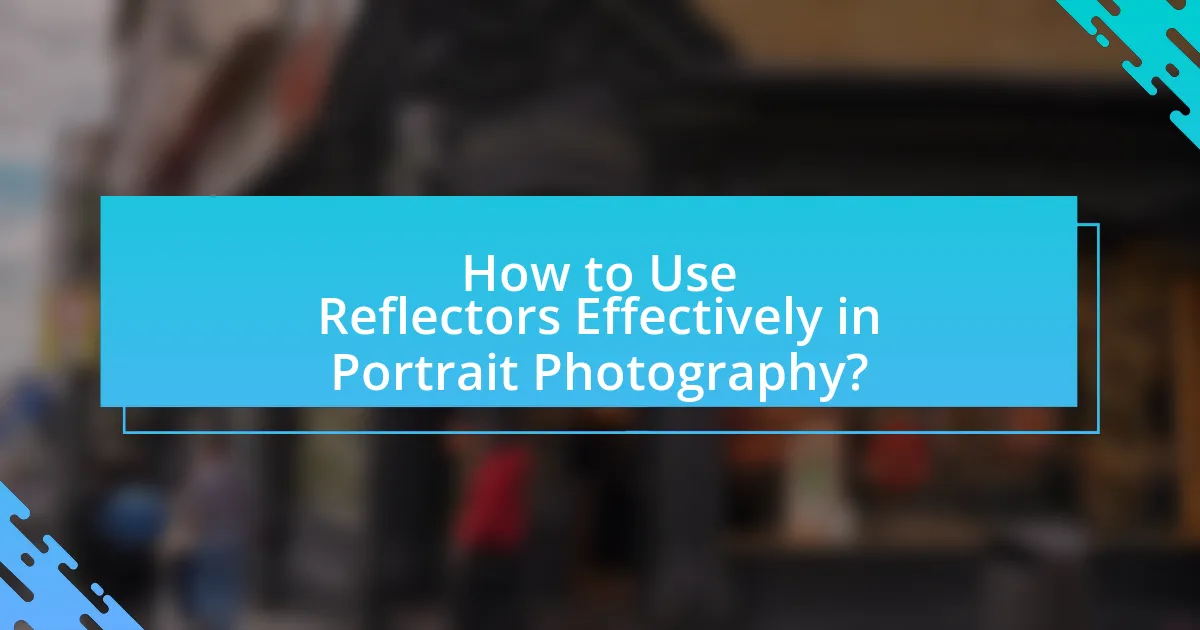
How to Use Reflectors Effectively in Portrait Photography?
To use reflectors effectively in portrait photography, position the reflector to bounce light onto the subject’s face, enhancing illumination and reducing shadows. This technique improves the overall quality of the portrait by creating a more flattering light. For instance, using a white reflector can soften harsh sunlight, while a gold reflector adds warmth to the skin tones. Studies show that proper use of reflectors can significantly enhance the visual appeal of portraits, making them more engaging and professional.
What Techniques Can Be Used to Position Reflectors?
Techniques to position reflectors include angling them to bounce light onto the subject, adjusting their distance from the subject to control light intensity, and using multiple reflectors to create a balanced light effect. Angling the reflector at approximately 45 degrees to the subject often yields the best results, as it allows for optimal light diffusion. The distance can be modified based on the desired softness or harshness of the light; closer reflectors produce softer light, while those further away create a more diffused effect. Additionally, employing multiple reflectors can help fill in shadows and enhance highlights, leading to a more dynamic portrait. These techniques are widely recognized in portrait photography for their effectiveness in manipulating natural and artificial light sources.
How Can You Determine the Best Angle for a Reflector?
To determine the best angle for a reflector, position the reflector at an angle that maximizes the light’s bounce onto the subject’s face. This typically involves angling the reflector towards the light source while ensuring it reflects light onto the subject without causing harsh shadows. The effectiveness of this angle can be validated by observing the quality of light on the subject; soft, diffused light indicates an optimal angle. Experimentation with different angles and distances can further refine the results, as the ideal angle may vary based on the specific lighting conditions and the subject’s features.
What Are Common Mistakes to Avoid When Using Reflectors?
Common mistakes to avoid when using reflectors include improper positioning, which can lead to unflattering light on the subject. Positioning the reflector too close or too far from the subject can create harsh shadows or insufficient light, respectively. Additionally, using the wrong type of reflector for the lighting conditions can result in undesirable color casts; for instance, a silver reflector in warm light may create an overly cool tone. Not considering the angle of the light source can also lead to uneven illumination, diminishing the overall quality of the portrait. Lastly, neglecting to communicate with the subject about the reflector’s placement can result in awkward poses or expressions, ultimately affecting the photograph’s outcome.
How Can You Combine Reflectors with Other Lighting Equipment?
You can combine reflectors with other lighting equipment by positioning them strategically to enhance or modify the light produced by the primary source. For instance, using a reflector alongside a key light can fill in shadows and create a more balanced exposure on the subject. This technique is commonly employed in portrait photography to achieve a soft, flattering light. Studies in lighting design indicate that reflectors can increase the overall light output by up to 50%, making them an effective tool when paired with artificial lights like softboxes or strobes.
What Benefits Does Combining Reflectors with Flash Provide?
Combining reflectors with flash enhances lighting control and improves image quality in portrait photography. Reflectors bounce light from the flash, softening shadows and creating a more even illumination on the subject’s face. This technique allows photographers to fill in dark areas without overexposing highlights, resulting in a balanced exposure. Additionally, using reflectors can add warmth or color to the light, enriching the overall aesthetic of the portrait. Studies in photography techniques confirm that the combination of reflectors and flash leads to more dynamic and visually appealing images, as it allows for greater versatility in lighting setups.
How Can Reflectors Work with Natural Light Sources?
Reflectors can enhance natural light sources by redirecting and diffusing sunlight to illuminate subjects more effectively. By positioning reflectors strategically, photographers can bounce sunlight onto the subject, filling in shadows and creating a more balanced exposure. For instance, using a white or silver reflector can increase the light intensity on the subject’s face, improving the overall quality of the portrait. Studies in photography demonstrate that reflectors can increase the perceived brightness of a scene by up to 50%, making them a valuable tool for achieving optimal lighting conditions in portrait photography.
What Are Some Practical Tips for Using Reflectors in Portrait Photography?
To effectively use reflectors in portrait photography, position the reflector at an angle that directs light onto the subject’s face, enhancing illumination and reducing shadows. This technique is crucial for achieving balanced lighting, especially in outdoor settings where natural light can create harsh contrasts. Additionally, selecting the appropriate reflector color—white for soft light, silver for increased brightness, and gold for warmth—can significantly influence the mood of the portrait. Studies show that using reflectors can improve the overall quality of images by providing a more flattering light source, which is essential for capturing the subject’s features accurately.




